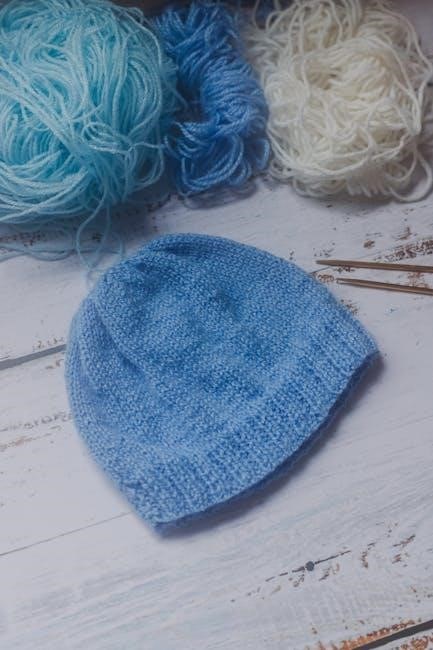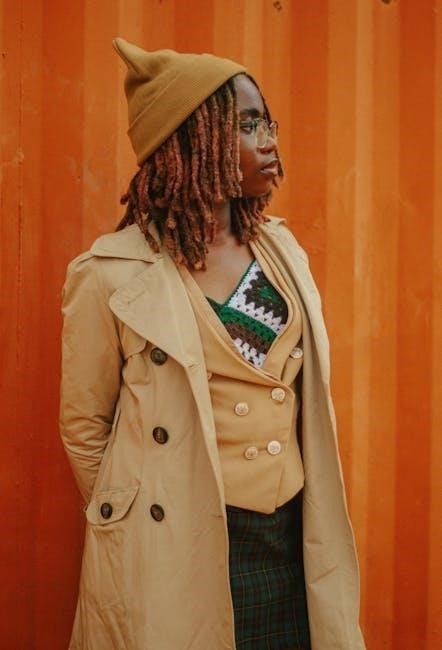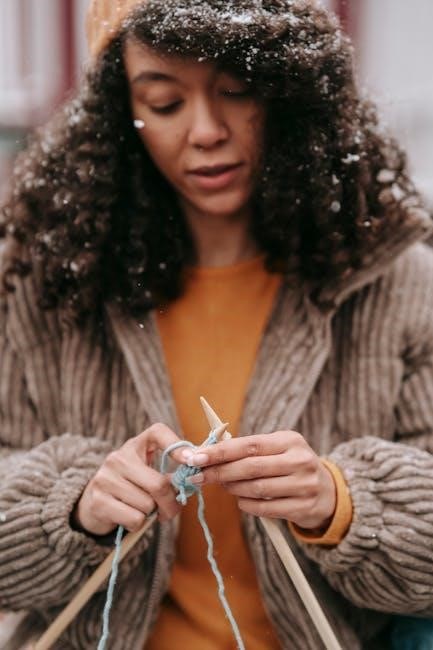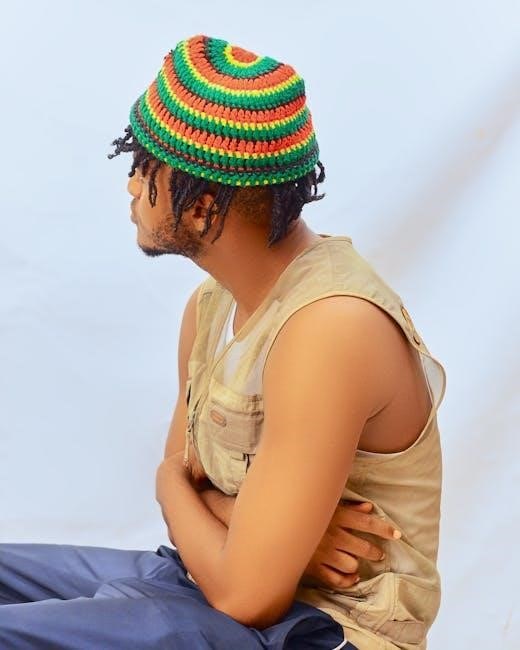Understanding crochet beanie sizing ensures a proper fit, comfort, and style. This guide helps you navigate head measurements, age categories, and customization tips for the perfect beanie.
Why Proper Fit Matters in Crochet Beanies
A well-fitting crochet beanie is essential for both style and comfort. A beanie that is too tight can cause discomfort or even headaches, while one that is too loose may not stay in place or provide adequate warmth. Proper fit ensures the beanie sits comfortably, maintains its shape, and serves its purpose, whether it’s for warmth, fashion, or both. Additionally, a correctly sized beanie enhances the overall appearance, ensuring it looks as intended. Achieving the right balance prevents the hat from slipping or sagging, making it more functional and visually appealing. A good fit also boosts confidence, as the wearer feels the beanie complements their style and meets their needs effectively.
Understanding Head Circumference and Hat Measurements
Head circumference is the key measurement for crochet beanies, typically ranging from 12 inches for newborns to 24 inches for adults. Proper hat measurements, including crown and brim, ensure a comfortable fit. The crown refers to the top part, while the brim is the folded edge. Standard size charts categorize sizes by age, with newborns, infants, children, teenagers, and adults each having specific ranges. Accurate measurements guide the pattern selection, ensuring the beanie is neither too tight nor too loose. Using a tape measure around the widest part of the head provides precise data, helping crocheters create hats that fit well and look great, ensuring both comfort and style for the wearer.

Standard Crochet Beanie Size Charts
Standard crochet beanie size charts categorize hats by age, with measurements ranging from 12-14 inches for newborns to 20-24 inches for adults, ensuring a tailored fit.
Age-Based Size Categories
Crochet beanie size charts typically categorize hats into age-based groups, including newborns, infants, children, teenagers, and adults. Newborn sizes range from 12-14 inches in circumference, infants from 14-16 inches, and children from 16-18 inches. Teenagers and small adults often fit into 18-20 inch sizes, while average adults range from 20-22 inches. Larger adult sizes can go up to 24 inches; These categories provide a general guide, but individual head sizes may vary, emphasizing the importance of precise measurements for a perfect fit. Age-based sizing is a convenient starting point, but adjustments may be needed based on personal preferences or specific styles.
Measurements for Newborns and Infants
Newborn and infant crochet beanies require precise measurements for a snug, comfortable fit. Newborn sizes typically range from 12-14 inches in head circumference, with beanies measuring 1-3 inches smaller for a proper fit. Infants usually fall into the 14-16 inch range, with beanies slightly smaller to ensure comfort and safety. The height of the beanie generally ranges from 6-8 inches, depending on the desired style. These measurements are designed to accommodate the rapid growth of babies while ensuring the beanie stays securely in place. Proper sizing is essential for both comfort and safety, making these guidelines a reliable starting point for crocheting beanies for little ones.
Measurements for Children and Teenagers
For children and teenagers, crochet beanie sizing varies based on age and head size. Typically, head circumferences range from 16-20 inches for children aged 2-12 years, with beanie sizes adjusting accordingly. Teenagers usually fall into the 18-22 inch range. Beanie heights generally range from 8-10 inches, allowing for a comfortable fit without being too bulky. These measurements ensure the beanie stays in place while accommodating growth. Proper sizing is crucial for comfort and style, making these guidelines a great starting point for crocheting beanies for kids and teens of all ages.
Measurements for Adults
For adults, head circumferences typically range from 20 to 24 inches, with corresponding beanie sizes adjusted to fit comfortably. Generally, adult beanies measure between 9 to 11 inches in height, allowing for a snug fit that isn’t too tight. Proper sizing ensures the beanie stays in place while maintaining a stylish appearance. These measurements are crucial for creating a beanie that is both functional and fashionable, catering to individual preferences and head sizes. By adhering to these guidelines, crocheters can craft beanies that offer comfort and style for adults of all ages.
Understanding Crochet Beanie Styles
Crochet beanies come in various styles, such as slouchy, fitted, and trendy designs, each offering unique looks for different preferences and occasions, appealing to both casual and stylish wearers.
Slouchy Beanies vs. Fitted Beanies
Slouchy beanies are designed to be loose-fitting and stylish, often extending beyond the crown for a trendy look. They are perfect for fashion-forward individuals who want a relaxed, casual vibe. Fitted beanies, however, are designed to snugly hug the head, providing warmth and a sleek appearance. The choice between the two often depends on personal style, the intended use, and the desired level of comfort. Slouchy beanies are great for layering, while fitted beanies are ideal for colder climates. Both styles require precise measurements to ensure the best fit, but slouchy beanies offer more flexibility in sizing due to their forgiving design.
Adjusting for Different Beanie Styles
Adjusting patterns for various beanie styles involves modifying key elements like stitch count, row numbers, and yarn weight. Slouchy beanies require additional stitches or rows to achieve the desired slouch, while fitted beanies need precise tension to ensure a snug fit. Adding or subtracting increase rounds can alter the crown size, and varying the height adjusts the overall look. Using different yarn weights can also impact the drape and fit. It’s essential to swatch and measure as you go to maintain the intended style. Understanding how these adjustments affect the final product ensures your crochet beanies meet both functional and aesthetic goals.

Measuring for the Perfect Fit
Accurate head circumference measurements are key to a well-fitting crochet beanie. Use a flexible tape measure to ensure proper fit and comfort for any beanie style.
How to Measure Head Circumference
To ensure the perfect fit for your crochet beanie, accurately measuring head circumference is essential. Use a flexible tape measure or a piece of string to wrap around the widest part of the head, just above the eyebrows and ears. Keep the tape measure level and not too tight or loose. For adults, the average head circumference ranges from 20-24 inches, while children’s sizes vary based on age. Record the measurement in inches or centimeters. This will help determine the correct size from the crochet beanie size chart. Proper measurement ensures comfort and style, whether you’re making a slouchy or fitted beanie. Always double-check your measurements for accuracy.
Understanding Crown and Brim Measurements
Understanding crown and brim measurements is crucial for crocheting beanies that fit perfectly. The crown refers to the top part of the hat, while the brim is the edge that sits on the forehead. Crown measurements typically range from 8-10 inches for adults, depending on style. The brim measurement varies based on whether the hat is slouchy or fitted. For a standard beanie, the brim is usually 2-3 inches wide, while slouchy styles may have a longer brim. Properly measuring these ensures the hat sits comfortably and maintains its shape. These measurements, combined with head circumference, help create a balanced and stylish beanie. Always consider the intended style when adjusting these measurements for the best results.
Importance of Swatching for Gauge
Swatching for gauge is a critical step in crocheting beanies to ensure proper fit and consistency. Gauge refers to the number of stitches and rows per inch, which varies based on yarn, hook size, and tension. Without an accurate gauge, your beanie may be too tight or too loose, regardless of measurements. Always crochet a swatch before starting your project to confirm your gauge matches the pattern. Adjusting hook size or yarn weight based on your swatch ensures the beanie will fit as intended. Neglecting this step can lead to resizing or reworking, wasting time and materials. Swatching is a simple yet essential process for achieving professional results.

Customizing Your Crochet Beanie
Customizing your crochet beanie allows for personalization, ensuring the perfect fit and style. Adjust patterns to suit individual preferences, experiment with colors, and incorporate unique embellishments for a personalized touch.
Adjusting Patterns for Individual Sizes
Adjusting crochet patterns to fit individual sizes ensures a personalized and comfortable beanie. Start by measuring the wearer’s head circumference to determine the correct size. Use a hat size calculator tool to find the appropriate measurements for different age groups, from newborns to adults. Modify the pattern by changing hook sizes or adjusting the number of stitches to achieve the desired fit. For example, increasing the hook size will result in a larger beanie, while decreasing it will make it smaller. Additionally, consider the style of the beanie, such as slouchy or fitted, and adjust the length and circumference accordingly. Swatching is essential to ensure the gauge matches the pattern, preventing sizing issues. By making these adjustments, you can create a beanie that fits perfectly and meets the wearer’s style preferences. This step-by-step approach ensures a professional finish and a satisfied recipient.
Using a Hat Size Calculator Tool
A hat size calculator tool is a valuable resource for ensuring accurate sizing in crochet projects. Simply input the wearer’s head circumference, age, and preferred style, and the tool provides tailored measurements for crown, brim, and height. This eliminates guesswork and helps achieve a perfect fit. Many calculators cater to various styles, such as slouchy or fitted beanies, and offer adjustments for different yarn types and stitch patterns. By using a calculator, crocheters can avoid common sizing mistakes and create beanies that are both comfortable and stylish. This tool is especially handy for beginners or those crafting for others, ensuring every project meets individual needs and preferences.

Common Mistakes in Crochet Beanie Sizing
Ignoring gauge measurements and not accounting for yarn stretch are common errors, leading to ill-fitting beanies. Always swatch and consider fabric drape for accurate sizing.
Ignoring Gauge Measurements
One of the most frequent errors in crochet beanie sizing is neglecting to check gauge, which is the number of stitches and rows per inch. Gauge affects the overall size of the beanie, as it determines how tightly or loosely the yarn is crocheted. Without an accurate gauge, a beanie intended for a child might end up fitting an adult, or vice versa. To avoid this, always create a gauge swatch before starting your project and compare it to the pattern’s specifications. Adjust your hook size if necessary to ensure the fabric will drape correctly and the beanie will fit as intended. This step is crucial for achieving the perfect fit and can save time and yarn in the long run. Additionally, consistent gauge ensures that the beanie’s shape and style match the pattern’s design, whether it’s a slouchy or fitted look. By prioritizing gauge measurements, crocheters can create beanies that are both comfortable and visually appealing. Remember, accurate gauge is the foundation of a well-fitting crochet project, so never skip this essential step. Proper gauge ensures that the beanie will have the correct circumference and height, making it suitable for the intended wearer. If the gauge is off, even by a small amount, it can significantly alter the finished size of the beanie. Therefore, taking the time to measure and adjust your gauge is an investment in the success of your crochet project. This attention to detail will result in a beanie that is not only functional but also flattering and enjoyable to wear. By understanding the importance of gauge, crocheters can avoid common sizing mistakes and consistently produce well-fitting beanies; Always keep in mind that gauge is the key to achieving professional-looking results in crochet. It may seem tedious, but the effort pays off in the quality of the finished product. So, before diving into your next project, make sure to swatch and check your gauge meticulously. Your finished beanie will thank you.
Not Accounting for Stretch in Yarn
Another common mistake is not considering the stretch of the yarn, which can significantly impact the fit of the beanie. Yarns vary in elasticity; for example, wool blends are more flexible than cotton. A beanie made with a highly stretchy yarn may grow larger over time, while one made with stiff yarn may feel too tight. To avoid this, choose yarns appropriate for the desired fit and test their stretchiness. Patterns designed for stretchy yarns often include instructions for slouchy or fitted styles, ensuring the beanie adapts to different head sizes. Always consider yarn stretch when selecting materials for a custom fit. This ensures the beanie remains comfortable and retains its shape over time. Accounting for stretch ensures your crochet projects are both functional and visually appealing. It is essential for achieving a perfect fit. Yarn stretch can make or break the usability of your beanie, so always keep it in mind when selecting materials. This step ensures your beanie is comfortable and retains its shape over time.
Crocheting a beanie that fits perfectly requires understanding sizing, measuring techniques, and yarn properties. By following these guidelines, you can create beanies that are both stylish and comfortable.
Final Tips for Achieving the Perfect Crochet Beanie Fit
Ensuring a perfect fit for your crochet beanie involves careful planning and execution. First, always measure the wearer’s head circumference accurately to determine the correct size. Use a flexible tape measure and ensure it’s level for precise results. Next, swatch your yarn to gauge the stitches accurately, as this directly affects the size. Consider the style—slouchy beanies may require a bit more fabric, while fitted ones should snugly fit. Adjust patterns based on personal preference and yarn stretch. Finally, don’t hesitate to use online calculators or size charts to cross-verify your measurements for the best outcomes. Happy crocheting!

